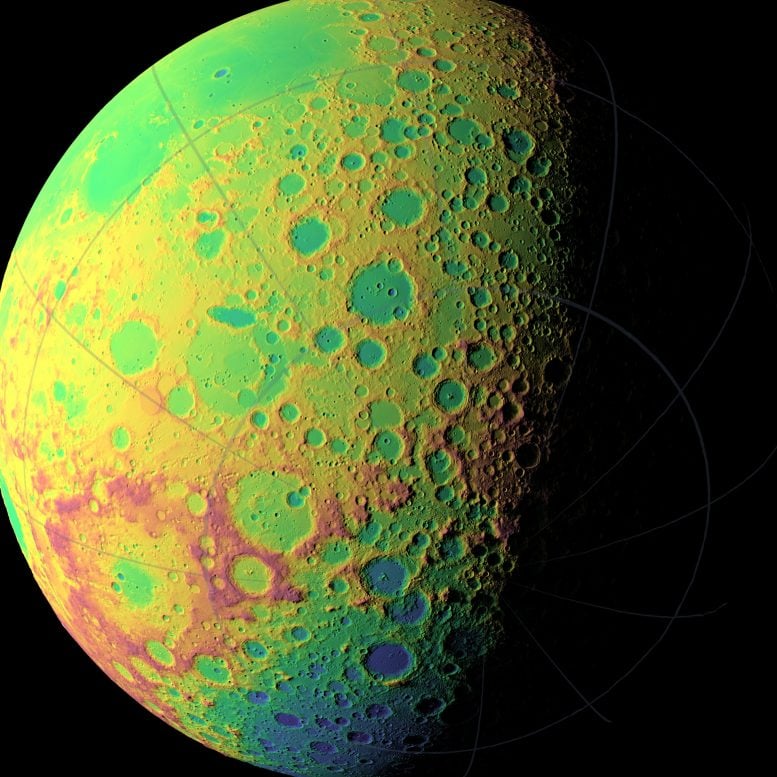
A false color view of the Moon’s southern latitudes. The large blue area at the bottom of the frame is the South Pole-Aitken Basin, an enormous and very old impact feature on the far side of the Moon. Credit: NASA/Goddard Space Flight Center Scientific Visualization Studio
The last screw is tightened and a private Moon lander is packed in the fairing atop a SpaceX Falcon 9 rocket at Cape Canaveral Air Force Station in Florida. It took eight years to get there, plus significant dedication by a small group of scientists and engineers building Israel’s first machine to leave Earth’s orbit. Now, the highly anticipated moment is here: a shot at the first private Moon landing, and NASA is contributing to the experiment.
An Israeli spacecraft from SpaceIL is scheduled to launch Thursday, February 21 and is aiming to touch down on Mare Serenitatis two months later. NASA installed a small laser retroreflector aboard the lander to test its potential as a navigation tool. The agency also provided images of the Moon’s surface to help the engineers identify a landing site for the mission. NASA will also use its deep space telecommunications network to transmit images and science data home to SpaceIL and its partners. Administrator Bridenstine signed an agreement with the Israel Space Agency (ISA) in July 2018 in order to collaborate with SpaceIL on the mission. SpaceIL will provide NASA scientific data from the spacecraft’s magnetometer as part of the collaboration.
“This is the type of collaboration that will become more frequent as NASA looks to expand opportunities with a greater variety of partners to continue the exploration of the Moon and Mars,” said Steve Clarke, NASA’s Deputy Associate Administrator for Exploration. “NASA is proud to work with the Israel Space Agency (ISA) and SpaceIL and we look forward to the landing and the science data that will be gained from this important mission.”
It takes a village
SpaceIL was established in 2010 to tackle the Lunar X Prize, a competition sponsored by Google that challenged private companies to land a spacecraft on the Moon. Though no company was able to meet the competition deadline, prompting Google to end it with no winner in March 2018, the Israeli team pressed on.
But no company can make it in space alone. SpaceIL will rely on the Swedish Space Corporation’s network of antennas to communicate navigation commands to the spacecraft and to track its trajectory. Once the spacecraft lands, NASA’s Deep Space Network (DSN) will ferry data between it and Earth. DSN is a system of global antennas managed by NASA’s Jet Propulsion Laboratory in Pasadena, California, that scientists use to communicate with spacecraft in deep space.
The SpaceIL mission advances a partnership between NASA and ISA as both agencies will share the resulting discoveries with the global scientific community.
“The team’s tension level is high, but we’re also very, very excited” said Eran Shmidt, deputy manager and head of the ground control team at SpaceIL, the Israeli nonprofit that built the Moon lander, called Beresheet, or “genesis” in Hebrew, in partnership with Israeli-government-owned defense contractor Israel Aerospace Industries.
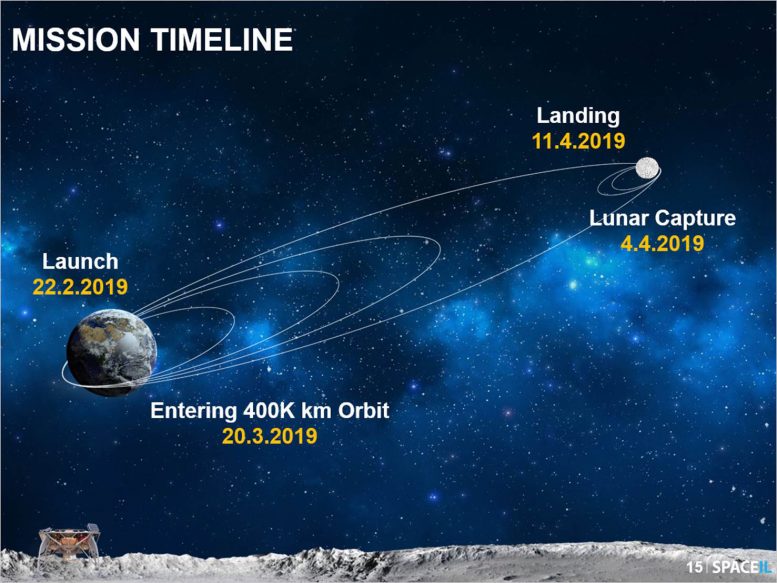
A graphic showing Beresheet’s path to the Moon. Dates correspond with Israel Standard Time. Credit: SpaceIL
Beresheet — about 5 feet (1 meter) tall by 7.5 feet (2.3 meters) wide with its landing gear and legs deployed — is one of two payloads that will hitch a ride aboard the Falcon 9 today. The other payload is an Earth telecommunications satellite. The lander will separate first from the rocket, taking the long route to the Moon to save fuel by employing gravitational forces to propel itself. Thus, Beresheet will stay in Earth’s orbit for about a month, slowly widening its ellipse until it reaches apogee, or its farthest point from here, at nearly 250,000 miles (400,000 kilometers) away. The SpaceIL team will need to time Beresheet’s apogee precisely to meet up with the Moon in its orbit about Earth. At this point, the navigators can slow the spacecraft to allow it to be captured by the Moon’s gravity and thereby pulled into its orbit.
“Once we are captured by the Moon,” said Shmidt, “we will orbit around it, perform a few maneuvers for about a week, and then start a 20- to 30-minute autonomous descent.”
A few moments of precious science
Beresheet is due to touch down between April 11 and 12 in a dark patch of an ancient volcanic field visible from Earth, known as the Sea of Serenity (Mare Serenitatis in Latin). NASA’s Apollo 17 astronauts landed near this region on December 11, 1972.
Now, Beresheet will have an opportunity to mark a new first in space exploration with its landing. Though the primary goal of its mission is to land safely, the spacecraft will attempt to do science in orbit, during landing, and on the ground. The window of research opportunity is small, though: just three Earth days maximum after landing that the spacecraft can withstand the crushing heat — 212 degrees Fahrenheit (100 degrees Celsius) at local noon — of the lunar day (14 Earth days). But every second counts to scientists back on Earth.
NASA’s Lunar Reconnaissance Orbiter (LRO), one of the agency’s three spacecraft circling and studying the Moon, will analyze the gases released by Beresheet’s decent engine as the lander approaches the surface.
“What we’re trying to learn is how volatile compounds, such as water or other gases, are transported around the Moon,” said John W. Keller, an LRO project scientist at NASA’s Goddard Space Flight Center in Greenbelt, Maryland. “If we can predict where these compounds will go and where they’ll settle, we’ll know in what regions of the Moon to look for water and other valuable resources.”
Meanwhile, scientists from the University of California in Los Angeles, Israel’s Weizmann Institute of Science, and other global organizations will rely on data from Beresheet’s magnetometer to study whether Moon rocks contain a history of the magnetic field there.
An old, new instrument
Another experiment on Beresheet will involve a tiny but robust instrument called a Laser Retroreflector Array. Smaller than a computer mouse, this device features eight mirrors made of quartz cube corners that are set into a dome-shaped aluminum frame. This configuration allows the device to reflect light coming in from any direction back to its source. LRO’s laser altimeter, an instrument that measures altitude, will try to shoot laser pulses at Beresheet’s retroreflector and then measure how long it takes the light to bounce back. By using this technique, engineers expect to be able to pinpoint Beresheet’s location within 4 inches (10 centimeters).
One day, this simple technology, requiring neither power nor maintenance, may make it easier to navigate to locations on the Moon, asteroids, and other bodies. It could also be dropped from a spacecraft onto the surface of a celestial body where the reflector could help scientists track the object’s spin rate or position in space.
“It’s a fixed marker you may return to it any time,” said David E. Smith, principal investigator of the Lunar Orbiter Laser Altimeter, or LOLA, on the LRO.
Laser retroreflectors have already been instrumental to space exploration. Apollo- astronauts left three large reflector panels at various Moon locations 50 years ago. They’re still reflecting light today, with their 100 mirrors each, though they’re reflecting light all the way back to Earth instead of a close-by orbiter. Using these mirrors, scientists have learned many things about the Moon, particularly that it is moving away from Earth at a rate of 1.5 inches (3.8 centimeters) per year.
These days, smaller laser reflectors are commonly used to track Earth-orbiting satellites from the ground and have been included in several recent space missions. NASA installed an Italian Space Agency-provided retroreflector on the deck of the InSight lander, which arrived on Mars in November 2018. Though there’s no orbiter with a laser instrument at Mars today to shoot light to InSight’s reflector, scientists expect that there will be one in the future.
In Beresheet’s case, too, the reflector will live on forever, even though Beresheet is expected to stop working within a few days of landing. It may be a simple dome of mirrors, yet Beresheet’s reflector may be one of the first flickers of light future explorers undertaking NASA’s Moon to Mars exploration will see as they descend to the Moon in the coming decade.

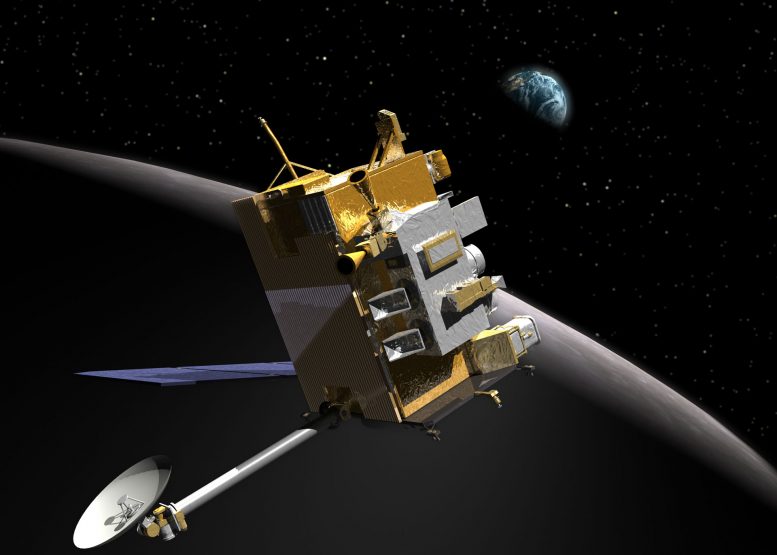
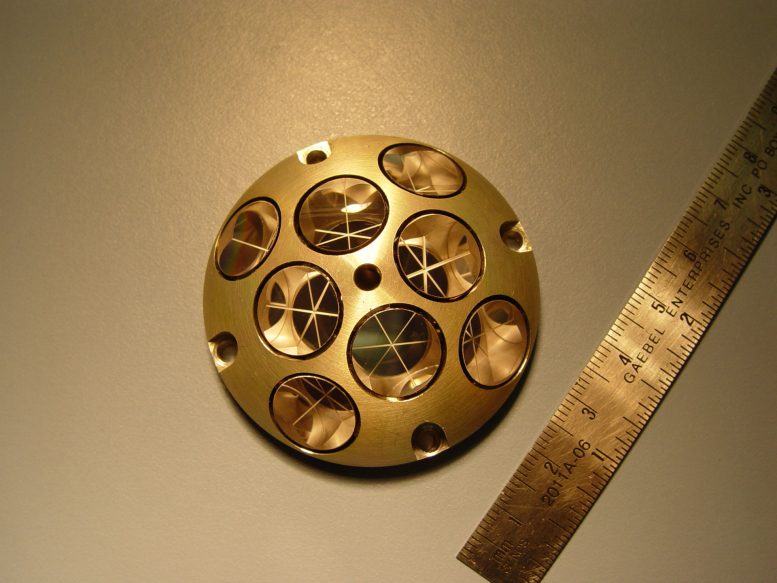


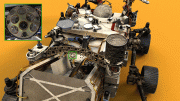
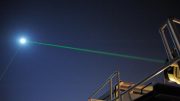
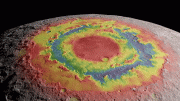

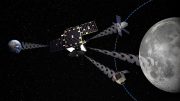
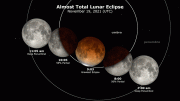
Nice story, but the change of a metre to 5ft may cause problems, and I hope the decent engines are also helpful for the descent.